ABSTRACT
Rice and its farming have been culturally the backbone of Japan's society so far. However, Japan's rice farming is facing an unprecedented turning point, in which this role will seemingly be doomed to being weakened due to the shrinking domestic demand. The purpose of this paper is to clarify the background of this turning point and consider possible strategies in order to recover the profitability of rice farming. One of the feasible strategies is to promote exporting more rice and its processed and high valued products, Sake. Exporting rice as grain form has also a possibility to enhance rice production, however, to reduce the cost and to strengthen the competitiveness is necessary because its price elasticity in exporting destinations is more than one. On the other hand, the price elasticity of Sake is lower. Both products' income elasticities for exporting are so higher that export increase will be expected along with economic growth in destination countries.
JEL classification: Q11, Q13, Q17, Q18
Key words: nutritional improvement, westernization, rice export promotion
INTRODUCTION
Japan's rice farming is in a severe condition, in which the domestic consumption is shrinking. Even its typical value-added product, i.e., Sake (alcohol beverage made from rice), the consumption of which is also declining. Such consumption shrinkings in rice and Sake have already been observed as per capita consumption. Moreover, from now on, it is predicted that these declining phenomena will be accelerated further by the population decrease.
Cultural and social westernization exists as a background for these consumption shrinkings. This westernization has intentionally been introduced by the government policy. In order to understand the severe situation in the rice and Sake markets, a review of the history of westernization of food life style in Japan is indispensable. In the next section, we review the history, then in section 3, we analyze the present situation, and finally explore strategies for the survival of Japan's rice farming in the future.
HISTORICAL BACKGROUND
Two times' westernization of foods and eating habits
Japan experienced two times' westernization of foods and eating habits including the government's intentional promotion.
In the 1860s, Japan started to modernize the country not only economically but also socially and culturally. To fulfill such an objective, the government had several policy measures, ranging from establishing steel-production factories to building a museum of a collection of western oil paintings. One of the polices in the field of social modernization was to promote eating beef instead of rice.
The government had been eager to introduce and disseminate western cultures. Eating beef was a typical example of the targets of westernization. Major newspapers also had raised slogans or published articles, saying that "eating beef" was a key step for Japan to catch up with western-modernized countries such as the Great Britain, France and Germany. The Japanese were and are still now Buddhists, and at that time, the Japanese were so pious Buddhists that most of them had a strong feeling of evasion against eating meats.
Despite the government efforts to promote western foods and eating habits, specifically eating beef instead of rice, people's daily food life had not changed significantly. Rather, since people could not have eaten rice sufficiently until 1870s, they had a desire to eat more rice. Actually, they usually had eaton barley[1] instead of rice. Therefore, after the modernization, along with economic growth, the rice consumption had increased dramatically.
Ironically, under the government promotion of western style foods and eating habits, rice consumption had increased drastically. Replacement of barley to rice caused this rice consumption increase. In the 1890s, Japan changed its position in the rice international trade from an exporting to an importing country.
The second opportunity to westernize Japanese foods and eating habits was during the 1950s, after Word War Ⅱ. At this time, the Japanese had an inferiority complex to Americans who boosted the campaign of westernization of foods and eating habits. In the last 1940s, the average life span of Japanese was 48, whereas Americans' was over 70. The average height of Japanese men adults was 157 cm., compared to the higher Americans, 178 cm[2].
The government campaign of westernization of foods and eating habits included the bi-partisan statement in the Parliament that Japanese should change traditional foods and eating habits with heavy dependence on rice to more westernized mode of eating by introducing milk and beef as replacements to rice and bread. Moreover, the so-called "kitchen cars" subsidized by the government visited around the country’s in rural areas to educate housewives to introduce western style dishes. Persons who educated the people recommended the eating of bread instead of rice. This government campaign of westernization on eating habits brought about a huge success.
Effects of westernization on eating habits in the long run
Specifically, one of the most effective ways to westernize eating habits was the school lunch westernization. Six times a week, every lunch, only bread had been provided as staple food, where rice had completely been excluded. This "no rice" school lunch continued from 1953 to 1975. This rule was clearly stipulated in the law, the School Lunch Act, enacted in 1954. This policy ended up reducing rice consumption dramatically, especially in the long run. The generation who did not eat rice at lunch soon had their families and raised children. In those homes, a limited number of rice dishes have been served.
Fig. 1 shows the trends of the consumption of bread compared to rice in households, not in school lunches. Even after the six days bread lunch system was introduced, its influence had not been explicit for almost 20 years. However, after that, when those generation was educated to eat bread in their daily lives and had their own families, the effect of such education was revealed gradually. Nowadays, expenditure to bread surpasses that to rice.
Of course, some elements of those westernization movement on eating habits should be appraised positively, especially intaking more amount of foods that contain rich protein, such as milk, eggs and meat. It must surely have contributed to longer Japanese average heights physically and prolong their life span with healthier life.
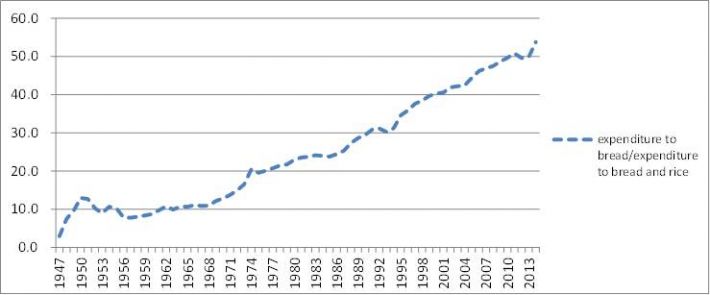
Fig. 1. Expenditure ratio of bread to rice + bread (%)
Source: The statistics for households consumption; The Statistics Bureau of Japan.
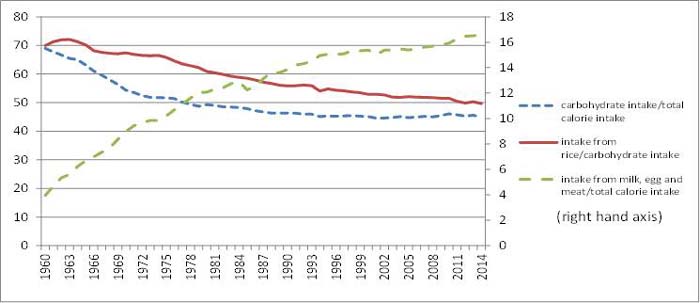
Fig. 2. Calorie intake ratio (%)
Source: Food demand and supply statistics tables; The Ministry of Agriculture of Japan.
Fig. 2 shows the tendency of calorie intake over the past 60 years. Within total calorie intake, the ratio of carbohydrate has been decreasing, while the ratio of calorie originated from meat, milk and eggs has been increasing. These changes have brought about positive effects to the poor protein food life in the rural areas in 1950s from a nutritional viewpoint[3].
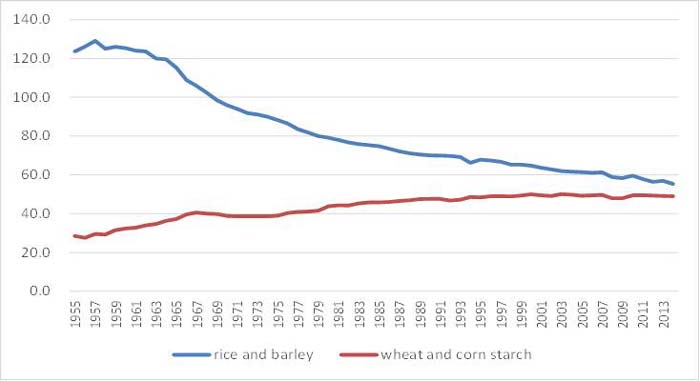
Fig. 3. carbohydrate consumption (kg/capita/year)
Source: The statistics for households consumption; The Statitics Bureau of Japan.
Fig. 3 also shows the effects of such westernization of foods and eating habits, specifically indicating the decline of rice consumption. The decreasing line shows the consumption of steamed rice and barley (recently 99% is rice) and the increasing line shows the consumption of wheat and other cereals consumed as powder form. It clearly shows that rice consumption became almost half during the past 60 years.
Rice policies faced with decreasing rice consumption
Due to shrinking consumption, Japan's rice policy over the past 50 years has principally been focusing on how to deal with overproduction problems. The acreage reduction has been established as the center of such a policy mix. Many developed countries were annoyed with overproduction issues in various crops and milk. Main causes of this problem were in the supply sides. By contrast, in the case of Japan, the main cause was demand side, that is, drastic and continuous rice consumption reduction.
Table 1. The history of rice policy
|
Period
|
Policy mix
|
|
1955-1969
|
two-tier price system alone
*1965-1969: over production
|
|
1970-1994
|
two-tier price system with acreage control (mandate)
*1980-1994: budget cutback and two prices became almost equal
(approximately price support system)
|
|
1995-2000
|
acreage control plus subsidies
|
|
2000-2006
|
acreage control plus counter cyclical payments
|
|
2007-2009
|
acreage control plus counter cyclical payments and direct payments
(limited to large farms)
|
|
2010-present
|
acreage control (voluntary) plus its compensation payment
|
Table 1 shows past policy measures that the government has adopted when it tackled this serious issue. In the 1960s, overproduction of rice was revealed and in 1970, the acreage reduction was introduced.
Present situation and key factors affecting the rice consumption decrease
Still, there are two negative factors that affect rice consumption's decline. One is the continually progressing of foods and eating habits westernization. The other is that the increase of fat intake may push out rice consumption within the limited calorie intake.
Continually progressing food culture's westernization
As mentioned before, the government policy to westernize Japan's foods and eating habits has succeeded. Ironically, however, it has succeeded in excess. Surely, the increase of protein-rich foods such as milk, eggs and meat are evaluated positively from the viewpoint of nutrition. However, the replacement of rice to bread has yielded a neutral effect on people's health. A serious side-effect is to culturally lose cuisines with Japanese tradition and to make farmers abandon their paddy fields.
In the 1960s, when the cultivated area for rice peaked 3.2 million hectares, rice consumption also reached the highest, 118 kg per capita. At present (2016), the cultivated area for rice is only 1.5 million hectares and the rice consumption is 55 kg per capita.
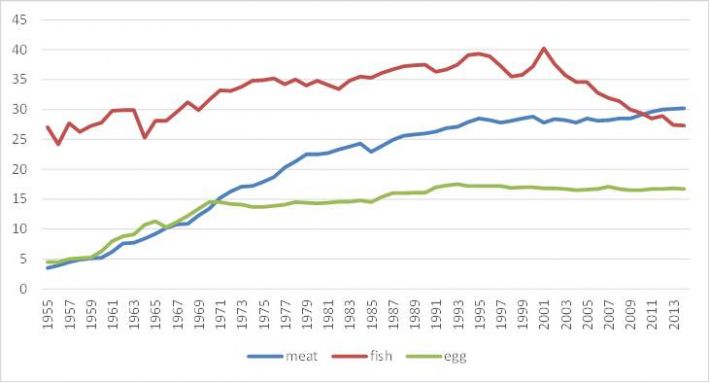
Fig. 4. Trends of fishes, meat and egg consumption (kg/capita/year)
Source: The statistics for households’ consumption; The Statistics Bureau of Japan.
Fig. 4 suggests a pessimistic future for rice consumption. Rice is consumed with other foods which are harmonized with each other. For example, raw fishes are specifically harmonized with rice, not with bread. Beef steak can choose either one as a combination staple food. However, drinking milk as liquid is not necessarily fitting with eating steamed rice. From this viewpoint, recent dramatic reduction of fish consumption may provide a fairly pessimistic view for rice consumption in the future.

Fig. 5. Trends of seasonings consumption (yen/household/year)
Source: The statistics for households’ consumption; The Statistics Bureau of Japan.
As considering the tendency of seasonings consumption, we must view the rice consumption in the future as not optimistic but pessimistic. This is depicted in Figure 5. Traditional Japanese seasonings such as "shouyu", soy sauce, and "miso", soy past, can well match with rice cuisines. Although younger generations have no hesitation to eat rice with mayonnaise, mayonnaise harmonizes with both rice and bread. Considering these combinations and the tendency shown in Figure 5, further shrinking of the rice consumption would be predicted.
Within limited amount of calorie intake, is rice pushed out by other foods?
Another negative factor that affects the rice consumption decrease is the increase of fat intake. This movement may push rice consumption to be more decreasing within limited calorie intake. In Japan, the obesity problem has still not become serious issue, however, people are aware of this issue. Currently, the obesity issue in other advanced countries, specifically in the U.S. is raising high concerns. The Japanese's total calorie intake has already been saturated. As shown in Figure 6, from 1970s to 1990s, fat intake has increased dramatically. As a result, there is no more room remaining to increaserice consumption, though sugar consumption is decreasing considerably. Rather too much westernization may bring about more fat intake. This may make rice consumption move backwards further more.
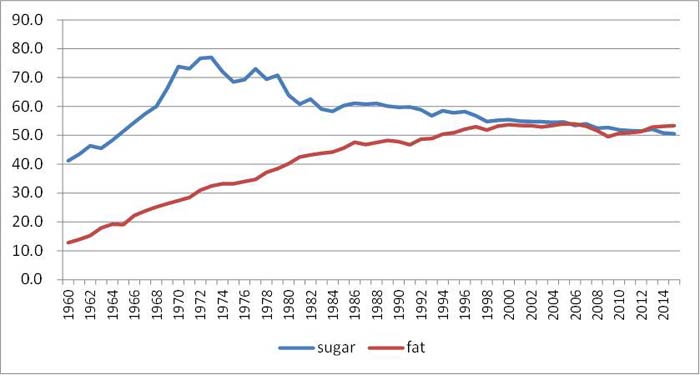
Fig. 6. Sugar and fat consumption (kg/capita/year)
Source: Food demand and supply statistics tables; The Ministry of Agriculture of Japan.
Still, Japanese food consumption and calorie intake may not become equal to those in western countries. Figure 7 shows that, in advanced countries, Japan's calorie intake has a unique position compared to other countries. When the economy develops, protein intake would increase and carbohydrate intake would decrease. However, there still exists uniqueness in every country's cultural tradition in food consumption. For example, Italy intakes higher calorie from carbohydrates. It is maybe due to its pasta tradition. On the other hand, the U.S. consumes more sugar and less other carbohydrate foods.

Fig. 7. International comparison of calorie intake among advanced countries[4]
Source: Food demand and supply statistics tables; The Ministry of Agriculture of Japan.
Nevertheless, even we admit such food cultural uniqueness in each countries' calorie intake, in Japan there should be no room to intake more calorie from rice.
Is it possible to maintain and recover Japan' rice production?
Under the declining consumption, Japan's rice industry is now facing a critical point, at which we consider strategies that can maintain the present production level, further being able to recover. There are two aspects, i.e., the one related to domestic consumption and the other for exports.
Maintaining domestic production by supplying rice for non-traditional usage
The tendency of gradually declining rice consumption in the Japan's domestic market cannot be reversed. The problem is not to change the direction but to alleviate the speed of declining.
Within the limited amount of Japan's domestic consumption, the supply side should keep up with its continuing westernization in food life styles. People are increasingly preferring pilaf, paella and Chinese-style fried rice rather than the traditional Japanese rice cuisines, in which rice is simply cooked by steaming. With regard to the criteria of quality, sticky rice is highly evaluated in traditional rice dishes. On the other hand, when rice is used in Chinese-style fried rice dishes and other newly introduced cuisines, sticky rice can not necessarily be evaluated higher.
The point is that sticky rice is evaluated with high-price, while less-sticky rice is transacted as low-priced. Farmers are reluctant to raise less-sticky rice even though varieties of less-sticky rice are expected to achieve high yield. In Japan, at present, the consumption of less-sticky rice is increasing. Nevertheless, producing rice for these usage does not mean producing value-added rice but producing rice with lower prices.
This contradiction cause serious problems. These various usage with lower priced rice are rather suitable to imported rice. Farmers' hesitated attitude to the production of less-sticky rice for non-traditional usage may bring about the replacement of domestically produced rice to imported rice. As things stand, Japan's rice market for domestically produced rice may shrink further more.
Exporting rice and its processed products, Sake: A promising strategy
Before arguing the exporting strategy for rice and its processed products, it is informative to review the present situation of the worldwide food market. Traditionally, foods are viewed as products less differentiated. Of course there exist quality differences in some foods, however, in other bulk foods, differences are not so distinctive and the degree of price range reflected such quality differences is not so large compared to other products such as clothing, automobiles and electric appliances. Usually, these product differentiations bring about "Intra-Industry Trade," in which some countries exports a certain goods even if it imports a large amount of the same goods.
Yet, recently, even foods with such features intrinsically, Intra-Industry Trade have prevailed. Fig. 8 shows this tendency. Seven foods except for beef[5] have indicated consistent progresses of Intra-Industry Trade.
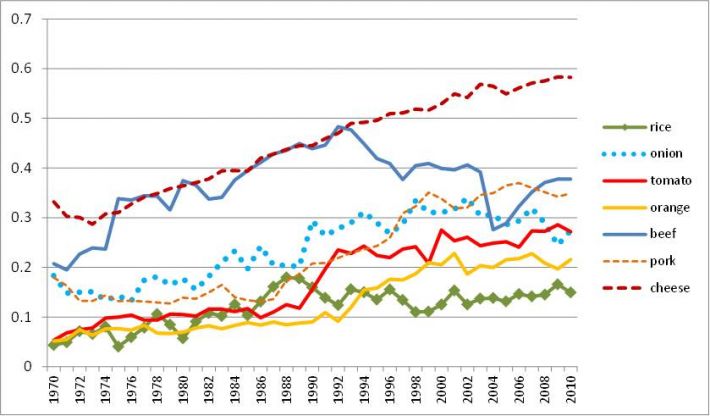
Fig. 8. Intra-Industry Trade on selected agricultural products (G.L.index)
Source: FAO-Stat; FAO.
In this context, it is not unusual phenomenon that, Japan, the typical rice importing country, in which the price competitiveness is inferior to other countries, would export rice and Sake.
With regard to sake, it should be emphasized that the domestic consumption of Sake is also shrinking and its producing firms are under severe financial situation, as same as rice farmers. Figure 9 shows these trends. The consumption of shouchu, which is made from sweet potatoes, and wine have increased consistently, while that of Sake has declined continuously.
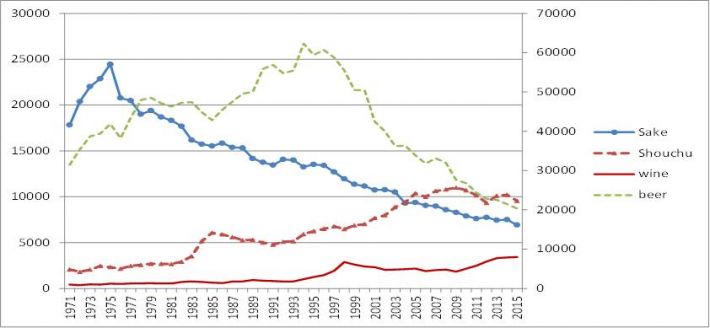
Fig. 9. Alcohol beverages consumption
Source: The statistics for households' consumption; The Statistics Bureau of Japan.
Fig. 10 shows recent rapid increase of rice and Sake exporting from Japan to the world. Considering the shrinking domestic consumption and pessimistic future prediction of consumption, it is appropriate to adopt the strategy of exporting rice and Sake.
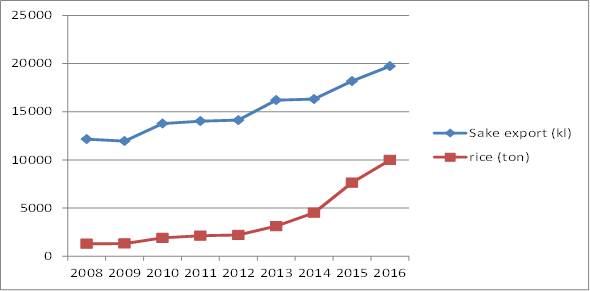
Fig. 10. Recent trends of exports of rice and Sake
Source: Statistics for Trade; The Ministry of Finance, Japan.
In order to establish a feasible strategy, it is needed to examine further the market conditions. Table 2 is the result of econometric estimation for rice export as grain form. Since its price elasticity in exporting countries is more than one, it is essential to enhance price competitiveness. In main exporting destinations, Asian high income countries such as Hong Kong, Taiwan and Singapore, a high price elasticity is estimated. Considering this fact, cost reduction is much more necessary.
With regard to income elasticity, generally high figures were estimated, specifically higher in western countries such as the U.S. and UK. This indicates promising expectation of the increase with the economic growths in those countries, however, on the other hand, it means that rice exporting is vulnerable when the economy in these countries fall into stagnation.
Table 2. Econometric analysis of Rice export (2008-2013)
|
|
price elasticity
|
income elasticity
|
adjusted-R-squared
|
|
World (26)
|
-1.476***
|
2.814
|
0.9307
|
|
Asian high income countries (3)
|
-3.435***
|
1.471
|
0.8762
|
|
Western countries (10)
|
-1.458***
|
4.473*
|
0.8489
|
Source: Statistics for Trade; The Ministry of Finance, Japan.
Table 3 shows the result of econometric estimation of Sake exportation. It shows lower price elasticity compared with rice as grain form. This may mean that Sake’s exporting is far beyond the price competition, thanks to its high quality evaluation. On the other hand, income elasticities for exporting are also high. An export increase will be expected along with economic growth, while it is needed to pay attention to sensitivity to economic conditions in exporting destination countries.
Table. 3. Econometric analysis of Sake export (2009-2016)
|
|
price elasticity
|
income elasticity
|
adjusted-R-squared
|
|
World (26)
|
-0.6952***
|
3.4417***
|
0.9524
|
|
Asian high income countries (3)
|
-0.8920***
|
6.1650***
|
0.9465
|
|
Western countries (10)
|
-0.3022*
|
1.8913*
|
0.9719
|
Source: Statistics for Trade; The Ministry of Finance, Japan.
CONCLUSION
Major findings of this paper are as follows:
First, Japan has tried to westernize its traditional eating habits throughout the government policies two times in the past. The second one achieved a huge success, however, ironically, this success caused dramatically the reduction of rice consumption.
Second, this policy effects has been fundamental in the long run through children's education and is still on going. From the viewpoint of westernization in foods and eating habits, rice consumption is hard to recover. Furthermore, from the nutritional point of view, appropriate calorie intake has been maturated so there is no more room to eat more rice.
Third, considering the above mentioned situation, promising strategies are limited. The most prospecting one is to promote exporting more rice and its processed and high valued products, Sake. With regard to exporting rice, to reduce the cost and to strengthen its competitiveness, it is indispensable because its price elasticity in exporting countries is more than one. On the other hand, the price elasticity of Sake is lower. Both products' income elasticities for exporting are so high that increasing exports will be expected along with economic growth in destination countries.
[1]Barley can be raised both on upland fields and paddy, in which it is grown by double-cropping as a winter crop combined with rice in summer. Historically, such convenience made poor peasants' economy in rural life heavily depending upon barley.
[2]At present, the average life span of Japanese is far beyond that of Americans. That of Japanese men is 81 and women 87. The height of Japanese also improved to 172 cm as for men adults.
[3]Recently, some experts say that this change went so excessively that the balance of foods intake is rather toward being unhealthier by too much meat eggs and milk.
[4]The lines do not continue smoothly due to data restriction. Until mid 1980s, the data had been the calorie intake from carbohydrate except for sugar. From 1990s to present, it includes sugar.
[5]The international trade of beef has severely been affected by the BSE epidemic disease. This should be considered as an exceptional case.
|
(Submitted as a paper for the International Seminar on “Promoting Rice Farmers’ Market through value-adding Activities”, June 6-7, 2018, Kasetsart University, Thailand)
|


Rice Farming in the Japan’s Matured Market: Overcoming the Shrinking Domestic Demand by Value-Adding and Export-Enhancing Strategies
ABSTRACT
Rice and its farming have been culturally the backbone of Japan's society so far. However, Japan's rice farming is facing an unprecedented turning point, in which this role will seemingly be doomed to being weakened due to the shrinking domestic demand. The purpose of this paper is to clarify the background of this turning point and consider possible strategies in order to recover the profitability of rice farming. One of the feasible strategies is to promote exporting more rice and its processed and high valued products, Sake. Exporting rice as grain form has also a possibility to enhance rice production, however, to reduce the cost and to strengthen the competitiveness is necessary because its price elasticity in exporting destinations is more than one. On the other hand, the price elasticity of Sake is lower. Both products' income elasticities for exporting are so higher that export increase will be expected along with economic growth in destination countries.
JEL classification: Q11, Q13, Q17, Q18
Key words: nutritional improvement, westernization, rice export promotion
INTRODUCTION
Japan's rice farming is in a severe condition, in which the domestic consumption is shrinking. Even its typical value-added product, i.e., Sake (alcohol beverage made from rice), the consumption of which is also declining. Such consumption shrinkings in rice and Sake have already been observed as per capita consumption. Moreover, from now on, it is predicted that these declining phenomena will be accelerated further by the population decrease.
Cultural and social westernization exists as a background for these consumption shrinkings. This westernization has intentionally been introduced by the government policy. In order to understand the severe situation in the rice and Sake markets, a review of the history of westernization of food life style in Japan is indispensable. In the next section, we review the history, then in section 3, we analyze the present situation, and finally explore strategies for the survival of Japan's rice farming in the future.
HISTORICAL BACKGROUND
Two times' westernization of foods and eating habits
Japan experienced two times' westernization of foods and eating habits including the government's intentional promotion.
In the 1860s, Japan started to modernize the country not only economically but also socially and culturally. To fulfill such an objective, the government had several policy measures, ranging from establishing steel-production factories to building a museum of a collection of western oil paintings. One of the polices in the field of social modernization was to promote eating beef instead of rice.
The government had been eager to introduce and disseminate western cultures. Eating beef was a typical example of the targets of westernization. Major newspapers also had raised slogans or published articles, saying that "eating beef" was a key step for Japan to catch up with western-modernized countries such as the Great Britain, France and Germany. The Japanese were and are still now Buddhists, and at that time, the Japanese were so pious Buddhists that most of them had a strong feeling of evasion against eating meats.
Despite the government efforts to promote western foods and eating habits, specifically eating beef instead of rice, people's daily food life had not changed significantly. Rather, since people could not have eaten rice sufficiently until 1870s, they had a desire to eat more rice. Actually, they usually had eaton barley[1] instead of rice. Therefore, after the modernization, along with economic growth, the rice consumption had increased dramatically.
Ironically, under the government promotion of western style foods and eating habits, rice consumption had increased drastically. Replacement of barley to rice caused this rice consumption increase. In the 1890s, Japan changed its position in the rice international trade from an exporting to an importing country.
The second opportunity to westernize Japanese foods and eating habits was during the 1950s, after Word War Ⅱ. At this time, the Japanese had an inferiority complex to Americans who boosted the campaign of westernization of foods and eating habits. In the last 1940s, the average life span of Japanese was 48, whereas Americans' was over 70. The average height of Japanese men adults was 157 cm., compared to the higher Americans, 178 cm[2].
The government campaign of westernization of foods and eating habits included the bi-partisan statement in the Parliament that Japanese should change traditional foods and eating habits with heavy dependence on rice to more westernized mode of eating by introducing milk and beef as replacements to rice and bread. Moreover, the so-called "kitchen cars" subsidized by the government visited around the country’s in rural areas to educate housewives to introduce western style dishes. Persons who educated the people recommended the eating of bread instead of rice. This government campaign of westernization on eating habits brought about a huge success.
Effects of westernization on eating habits in the long run
Specifically, one of the most effective ways to westernize eating habits was the school lunch westernization. Six times a week, every lunch, only bread had been provided as staple food, where rice had completely been excluded. This "no rice" school lunch continued from 1953 to 1975. This rule was clearly stipulated in the law, the School Lunch Act, enacted in 1954. This policy ended up reducing rice consumption dramatically, especially in the long run. The generation who did not eat rice at lunch soon had their families and raised children. In those homes, a limited number of rice dishes have been served.
Fig. 1 shows the trends of the consumption of bread compared to rice in households, not in school lunches. Even after the six days bread lunch system was introduced, its influence had not been explicit for almost 20 years. However, after that, when those generation was educated to eat bread in their daily lives and had their own families, the effect of such education was revealed gradually. Nowadays, expenditure to bread surpasses that to rice.
Of course, some elements of those westernization movement on eating habits should be appraised positively, especially intaking more amount of foods that contain rich protein, such as milk, eggs and meat. It must surely have contributed to longer Japanese average heights physically and prolong their life span with healthier life.
Fig. 1. Expenditure ratio of bread to rice + bread (%)
Source: The statistics for households consumption; The Statistics Bureau of Japan.
Fig. 2. Calorie intake ratio (%)
Source: Food demand and supply statistics tables; The Ministry of Agriculture of Japan.
Fig. 2 shows the tendency of calorie intake over the past 60 years. Within total calorie intake, the ratio of carbohydrate has been decreasing, while the ratio of calorie originated from meat, milk and eggs has been increasing. These changes have brought about positive effects to the poor protein food life in the rural areas in 1950s from a nutritional viewpoint[3].
Fig. 3. carbohydrate consumption (kg/capita/year)
Source: The statistics for households consumption; The Statitics Bureau of Japan.
Fig. 3 also shows the effects of such westernization of foods and eating habits, specifically indicating the decline of rice consumption. The decreasing line shows the consumption of steamed rice and barley (recently 99% is rice) and the increasing line shows the consumption of wheat and other cereals consumed as powder form. It clearly shows that rice consumption became almost half during the past 60 years.
Rice policies faced with decreasing rice consumption
Due to shrinking consumption, Japan's rice policy over the past 50 years has principally been focusing on how to deal with overproduction problems. The acreage reduction has been established as the center of such a policy mix. Many developed countries were annoyed with overproduction issues in various crops and milk. Main causes of this problem were in the supply sides. By contrast, in the case of Japan, the main cause was demand side, that is, drastic and continuous rice consumption reduction.
Table 1. The history of rice policy
Period
Policy mix
1955-1969
two-tier price system alone
*1965-1969: over production
1970-1994
two-tier price system with acreage control (mandate)
*1980-1994: budget cutback and two prices became almost equal
(approximately price support system)
1995-2000
acreage control plus subsidies
2000-2006
acreage control plus counter cyclical payments
2007-2009
acreage control plus counter cyclical payments and direct payments
(limited to large farms)
2010-present
acreage control (voluntary) plus its compensation payment
Table 1 shows past policy measures that the government has adopted when it tackled this serious issue. In the 1960s, overproduction of rice was revealed and in 1970, the acreage reduction was introduced.
Present situation and key factors affecting the rice consumption decrease
Still, there are two negative factors that affect rice consumption's decline. One is the continually progressing of foods and eating habits westernization. The other is that the increase of fat intake may push out rice consumption within the limited calorie intake.
Continually progressing food culture's westernization
As mentioned before, the government policy to westernize Japan's foods and eating habits has succeeded. Ironically, however, it has succeeded in excess. Surely, the increase of protein-rich foods such as milk, eggs and meat are evaluated positively from the viewpoint of nutrition. However, the replacement of rice to bread has yielded a neutral effect on people's health. A serious side-effect is to culturally lose cuisines with Japanese tradition and to make farmers abandon their paddy fields.
In the 1960s, when the cultivated area for rice peaked 3.2 million hectares, rice consumption also reached the highest, 118 kg per capita. At present (2016), the cultivated area for rice is only 1.5 million hectares and the rice consumption is 55 kg per capita.
Fig. 4. Trends of fishes, meat and egg consumption (kg/capita/year)
Source: The statistics for households’ consumption; The Statistics Bureau of Japan.
Fig. 4 suggests a pessimistic future for rice consumption. Rice is consumed with other foods which are harmonized with each other. For example, raw fishes are specifically harmonized with rice, not with bread. Beef steak can choose either one as a combination staple food. However, drinking milk as liquid is not necessarily fitting with eating steamed rice. From this viewpoint, recent dramatic reduction of fish consumption may provide a fairly pessimistic view for rice consumption in the future.
Fig. 5. Trends of seasonings consumption (yen/household/year)
Source: The statistics for households’ consumption; The Statistics Bureau of Japan.
As considering the tendency of seasonings consumption, we must view the rice consumption in the future as not optimistic but pessimistic. This is depicted in Figure 5. Traditional Japanese seasonings such as "shouyu", soy sauce, and "miso", soy past, can well match with rice cuisines. Although younger generations have no hesitation to eat rice with mayonnaise, mayonnaise harmonizes with both rice and bread. Considering these combinations and the tendency shown in Figure 5, further shrinking of the rice consumption would be predicted.
Within limited amount of calorie intake, is rice pushed out by other foods?
Another negative factor that affects the rice consumption decrease is the increase of fat intake. This movement may push rice consumption to be more decreasing within limited calorie intake. In Japan, the obesity problem has still not become serious issue, however, people are aware of this issue. Currently, the obesity issue in other advanced countries, specifically in the U.S. is raising high concerns. The Japanese's total calorie intake has already been saturated. As shown in Figure 6, from 1970s to 1990s, fat intake has increased dramatically. As a result, there is no more room remaining to increaserice consumption, though sugar consumption is decreasing considerably. Rather too much westernization may bring about more fat intake. This may make rice consumption move backwards further more.
Fig. 6. Sugar and fat consumption (kg/capita/year)
Source: Food demand and supply statistics tables; The Ministry of Agriculture of Japan.
Still, Japanese food consumption and calorie intake may not become equal to those in western countries. Figure 7 shows that, in advanced countries, Japan's calorie intake has a unique position compared to other countries. When the economy develops, protein intake would increase and carbohydrate intake would decrease. However, there still exists uniqueness in every country's cultural tradition in food consumption. For example, Italy intakes higher calorie from carbohydrates. It is maybe due to its pasta tradition. On the other hand, the U.S. consumes more sugar and less other carbohydrate foods.
Fig. 7. International comparison of calorie intake among advanced countries[4]
Source: Food demand and supply statistics tables; The Ministry of Agriculture of Japan.
Nevertheless, even we admit such food cultural uniqueness in each countries' calorie intake, in Japan there should be no room to intake more calorie from rice.
Is it possible to maintain and recover Japan' rice production?
Under the declining consumption, Japan's rice industry is now facing a critical point, at which we consider strategies that can maintain the present production level, further being able to recover. There are two aspects, i.e., the one related to domestic consumption and the other for exports.
Maintaining domestic production by supplying rice for non-traditional usage
The tendency of gradually declining rice consumption in the Japan's domestic market cannot be reversed. The problem is not to change the direction but to alleviate the speed of declining.
Within the limited amount of Japan's domestic consumption, the supply side should keep up with its continuing westernization in food life styles. People are increasingly preferring pilaf, paella and Chinese-style fried rice rather than the traditional Japanese rice cuisines, in which rice is simply cooked by steaming. With regard to the criteria of quality, sticky rice is highly evaluated in traditional rice dishes. On the other hand, when rice is used in Chinese-style fried rice dishes and other newly introduced cuisines, sticky rice can not necessarily be evaluated higher.
The point is that sticky rice is evaluated with high-price, while less-sticky rice is transacted as low-priced. Farmers are reluctant to raise less-sticky rice even though varieties of less-sticky rice are expected to achieve high yield. In Japan, at present, the consumption of less-sticky rice is increasing. Nevertheless, producing rice for these usage does not mean producing value-added rice but producing rice with lower prices.
This contradiction cause serious problems. These various usage with lower priced rice are rather suitable to imported rice. Farmers' hesitated attitude to the production of less-sticky rice for non-traditional usage may bring about the replacement of domestically produced rice to imported rice. As things stand, Japan's rice market for domestically produced rice may shrink further more.
Exporting rice and its processed products, Sake: A promising strategy
Before arguing the exporting strategy for rice and its processed products, it is informative to review the present situation of the worldwide food market. Traditionally, foods are viewed as products less differentiated. Of course there exist quality differences in some foods, however, in other bulk foods, differences are not so distinctive and the degree of price range reflected such quality differences is not so large compared to other products such as clothing, automobiles and electric appliances. Usually, these product differentiations bring about "Intra-Industry Trade," in which some countries exports a certain goods even if it imports a large amount of the same goods.
Yet, recently, even foods with such features intrinsically, Intra-Industry Trade have prevailed. Fig. 8 shows this tendency. Seven foods except for beef[5] have indicated consistent progresses of Intra-Industry Trade.
Fig. 8. Intra-Industry Trade on selected agricultural products (G.L.index)
Source: FAO-Stat; FAO.
In this context, it is not unusual phenomenon that, Japan, the typical rice importing country, in which the price competitiveness is inferior to other countries, would export rice and Sake.
With regard to sake, it should be emphasized that the domestic consumption of Sake is also shrinking and its producing firms are under severe financial situation, as same as rice farmers. Figure 9 shows these trends. The consumption of shouchu, which is made from sweet potatoes, and wine have increased consistently, while that of Sake has declined continuously.
Fig. 9. Alcohol beverages consumption
Source: The statistics for households' consumption; The Statistics Bureau of Japan.
Fig. 10 shows recent rapid increase of rice and Sake exporting from Japan to the world. Considering the shrinking domestic consumption and pessimistic future prediction of consumption, it is appropriate to adopt the strategy of exporting rice and Sake.
Fig. 10. Recent trends of exports of rice and Sake
Source: Statistics for Trade; The Ministry of Finance, Japan.
In order to establish a feasible strategy, it is needed to examine further the market conditions. Table 2 is the result of econometric estimation for rice export as grain form. Since its price elasticity in exporting countries is more than one, it is essential to enhance price competitiveness. In main exporting destinations, Asian high income countries such as Hong Kong, Taiwan and Singapore, a high price elasticity is estimated. Considering this fact, cost reduction is much more necessary.
With regard to income elasticity, generally high figures were estimated, specifically higher in western countries such as the U.S. and UK. This indicates promising expectation of the increase with the economic growths in those countries, however, on the other hand, it means that rice exporting is vulnerable when the economy in these countries fall into stagnation.
Table 2. Econometric analysis of Rice export (2008-2013)
price elasticity
income elasticity
adjusted-R-squared
World (26)
-1.476***
2.814
0.9307
Asian high income countries (3)
-3.435***
1.471
0.8762
Western countries (10)
-1.458***
4.473*
0.8489
Source: Statistics for Trade; The Ministry of Finance, Japan.
Table 3 shows the result of econometric estimation of Sake exportation. It shows lower price elasticity compared with rice as grain form. This may mean that Sake’s exporting is far beyond the price competition, thanks to its high quality evaluation. On the other hand, income elasticities for exporting are also high. An export increase will be expected along with economic growth, while it is needed to pay attention to sensitivity to economic conditions in exporting destination countries.
Table. 3. Econometric analysis of Sake export (2009-2016)
price elasticity
income elasticity
adjusted-R-squared
World (26)
-0.6952***
3.4417***
0.9524
Asian high income countries (3)
-0.8920***
6.1650***
0.9465
Western countries (10)
-0.3022*
1.8913*
0.9719
Source: Statistics for Trade; The Ministry of Finance, Japan.
CONCLUSION
Major findings of this paper are as follows:
First, Japan has tried to westernize its traditional eating habits throughout the government policies two times in the past. The second one achieved a huge success, however, ironically, this success caused dramatically the reduction of rice consumption.
Second, this policy effects has been fundamental in the long run through children's education and is still on going. From the viewpoint of westernization in foods and eating habits, rice consumption is hard to recover. Furthermore, from the nutritional point of view, appropriate calorie intake has been maturated so there is no more room to eat more rice.
Third, considering the above mentioned situation, promising strategies are limited. The most prospecting one is to promote exporting more rice and its processed and high valued products, Sake. With regard to exporting rice, to reduce the cost and to strengthen its competitiveness, it is indispensable because its price elasticity in exporting countries is more than one. On the other hand, the price elasticity of Sake is lower. Both products' income elasticities for exporting are so high that increasing exports will be expected along with economic growth in destination countries.
[1]Barley can be raised both on upland fields and paddy, in which it is grown by double-cropping as a winter crop combined with rice in summer. Historically, such convenience made poor peasants' economy in rural life heavily depending upon barley.
[2]At present, the average life span of Japanese is far beyond that of Americans. That of Japanese men is 81 and women 87. The height of Japanese also improved to 172 cm as for men adults.
[3]Recently, some experts say that this change went so excessively that the balance of foods intake is rather toward being unhealthier by too much meat eggs and milk.
[4]The lines do not continue smoothly due to data restriction. Until mid 1980s, the data had been the calorie intake from carbohydrate except for sugar. From 1990s to present, it includes sugar.
[5]The international trade of beef has severely been affected by the BSE epidemic disease. This should be considered as an exceptional case.
(Submitted as a paper for the International Seminar on “Promoting Rice Farmers’ Market through value-adding Activities”, June 6-7, 2018, Kasetsart University, Thailand)